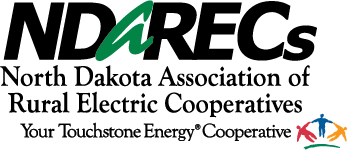Call us: 800-234-0518
Study reveals information gaps in 'news desert' counties

A recent survey found North Dakotans in “news desert” counties – areas without a local newspaper – feel less connected to their communities and less informed.
The survey, conducted by Coda Ventures as part of the ongoing Future of Local News initiative, had 128 respondents across Dunn, Sioux and Slope counties. The purpose was to explore how the absence of a local newspaper affects civic engagement and community awareness, while gauging potential support for improved local news services.
“Respondents made it clear local news is a vital link to community life,” says Ellen Huber, North Dakota Association of Rural Electric Cooperatives (NDAREC) rural development director. “Strengthening local journalism and local news businesses is foundational to strengthening the well-being of rural communities.”
Residents in the surveyed counties are served by newspapers in neighboring counties, including the Dickinson Press, Carson Press, Teton Times and Bowman County Pioneer, yet research indicates additional opportunities for locally based news sources to create more community connection and improve access to reliable information.
KEY FINDINGS
Awareness and impact of losing local newspapers: Among the 89% of residents who were aware their county no longer has a local newspaper, the consequences are tangible:
- 71% said they feel less aware of local events and community activities.
- 55% feel less informed about local government actions and projects.
- 52% feel less connected to their community.
- In Sioux County, more than half of respondents said their community’s economic well-being has declined since losing its local newspaper.
Civic engagement and community trust: If robust local coverage returned, respondents would be more likely to vote, support local businesses, attend community meetings and volunteer.
- Residents identified accurate reporting, balanced perspectives and holding public officials accountable as the top factors in building trust.
- Nearly half of respondents said they’ve noticed more misinformation and rumors since their communities lost local newspapers.
Desire for a new local newspaper: Nine in 10 respondents expressed interest in a new locally focused newspaper. Among them:
- 80% prefer a printed newspaper.
- 60% would read an e-edition.
- 54% would visit a local news website with daily updates.
- 87% said they would subscribe, one in four would advertise and one in five would donate to help fund journalists.
Social media reliance and distrust: Social media is heavily relied upon by residents – it’s the single most used information source across all three counties – but ranked low in trust. The study found:
- 83% of residents rely on social media for local news. In Dunn County, 94% reported using social media to stay informed.
- 52% of all respondents (only 30% in Slope County) consider social media reliable, versus 77% who said local or regional newspapers are trustworthy.
“I feel like I never know what’s going on around town or in the area,” one Dunn County respondent said.
“(I miss) hands-on access to information,” a Sioux County respondent said. “There’s too much reliance on social media, which is often inaccurate or frustrating. A local paper seems more associated with building community.”
Cecile Wehrman, North Dakota Newspaper Association (NDNA) executive director, says the survey results should serve as a catalyst toward preventing future news deserts.
“The anecdotes of real people living without a trusted local news source are a cautionary tale, not only for rural areas, but in larger communities where local news organizations need community support to survive,” she said.
The Future of Local News initiative is guided by a steering committee of media professionals and community leaders. The project is administered by NDAREC, in partnership with NDNA, and supported by a Bush Foundation Partnership Fund grant.
NDAREC is the statewide trade association for 17 electric distribution cooperatives and five generation and transmission cooperatives operating in North Dakota. The distribution cooperatives provide electricity to nearly 250,000 North Dakotans. NDAREC services include legislative advocacy, lineworker safety training, cooperative business and rural development, professional development and communication services, including publication of the North Dakota Living magazine.
